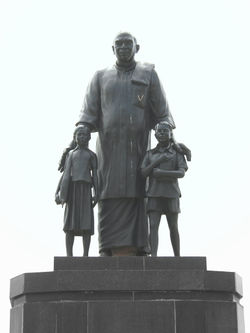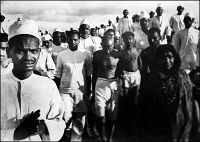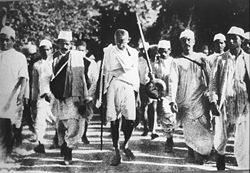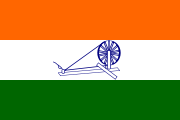K. Kamaraj
- In this Indian name, the name "Kumarasami" is a patronymic, not a family name, and the person should be referred to by the given name, "Kamaraj".
| K. Kamaraj | |
 |
|
|
Member of Parliament (Lok Sabha) for Nagercoil
|
|
| In office 1967–1975 |
|
| Preceded by | A. Nesamony |
|---|---|
| Succeeded by | Kumari Ananthan |
| Constituency | Nagercoil |
|
Member of Tamil Nadu Legislative Assembly for Sattur
|
|
| In office 1957–1967 |
|
| Preceded by | S. Ramaswamy Naidu |
| Succeeded by | S. Ramaswamy Naidu |
| Constituency | Sattur |
|
Member of Tamil Nadu Legislative Assembly for Gudiyatham
|
|
| In office 1954–1957 |
|
| Preceded by | Rathnaswamy and A. J. Arunachala Mudaliar |
| Succeeded by | V. K. Kothandaraman and T. Manavalan |
| Constituency | Gudiyatham |
|
Chief Minister of the Madras State (Tamil Nadu)
|
|
| In office 1954–1963 |
|
| Preceded by | C. Rajagopalachari |
| Succeeded by | M. Bhakthavatsalam |
|
Member of Parliament (Lok Sabha) for Srivilliputhur
|
|
| In office 1952–1954 |
|
| Preceded by | None |
| Succeeded by | S. S. Natarajan |
| Constituency | Srivilliputhur |
|
President of the Indian National Congress (Organisation)
|
|
| In office 1967–1971 |
|
| Preceded by | None |
| Succeeded by | Morarji Desai |
|
President of the Indian National Congress
|
|
| In office 1963–1967 |
|
| Preceded by | Neelam Sanjiva Reddy |
| Succeeded by | S. Nijalingappa |
|
President of the Madras Provincial Congress Committee
|
|
| In office 1946–1952 |
|
| Succeeded by | P. Subbarayan |
|
|
|
| Born | 15 July 1903 Virudhunagar, Tamil Nadu, India |
| Died | 2 October 1975 Chennai, Tamil Nadu, India |
| Nationality | Indian |
| Spouse(s) | NIL |
| Children | NIL |
| Religion | Hindu |
Kumarasami Kamaraj (Tamil: காமராஜ்) better known as K. Kamaraj (15 July 1903[1] – 2 October 1975[2]) was an Indian politician from Tamil Nadu widely acknowledged as the "Kingmaker" in Indian politics during the 1960s. He was the chief minister of Tamil Nadu during 1954-1963 and a Member of Parliament during 1952-1954 and 1969-1975. He was known for his simplicity and integrity.[1][3]
He was involved in the Indian independence movement.[4] As a high ranking office bearer of the Indian National Congress, he was instrumental in bringing to power two Prime Ministers, Lal Bahadur Shastri in 1964 and Indira Gandhi in 1966. In Tamil Nadu, his home state, he is still remembered for bringing school education to millions of the rural poor by introducing free education and the free Mid-day Meal Scheme during his tenure as chief minister. He was awarded India's highest civilian honour, the Bharat Ratna, posthumously in 1976. The domestic terminal of the Chennai airport is named "Kamaraj Terminal" in his honour and the Madurai Kamaraj University has been renamed after him.[3][5]
Contents |
Early life
Kamaraj was born on 15 July 1903 to Kumarasamy Nadar and Sivakami Ammal at Virudhunagar in Tamil Nadu. His parents were from a trading family. His father Kumarasamy Nadar, was a coconut merchant. Kamaraj was initially enrolled in the Enadhy Nayanar Vidyalaya elementary school, and later in high school Kshatriya Vidyalaya. Kamaraj's father died when he was six years old and his mother was forced to support her family by selling her jewellery. In 1914, Kamaraj dropped out of school to support his family.[6]
Start in politics and freedom struggle
Kamaraj joined as an apprentice in his maternal uncle Karuppiah's cloth shop after dropping out of school. He would slip out from the shop to join processions and attend public meetings addressed by orators like Dr. P. Varadarajulu Naidu . His relatives frowned upon Kamaraj 's budding interest in politics. They sent him to Thiruvananthapuram to work at another uncle's timer shop.
At the age of 16, Kamaraj enrolled himself as full-time worker of the Congress Party. He invited speakers, organized meetings and collected funds for the party. He also participated in the march to Vedaranyam led by C. Rajagopalachari as part of the Salt Satyagraha of March 1930.
Kamaraj was arrested and sent to Alipore Jail in Calcutta for two years. He was 27 at the time of his arrest and was released in 1931 following the Gandhi-Irwin Pact. Kamaraj was implicated in the Virudhunagar bomb case two years later.DrP. Varadarajulu Naidu and George Joseph argued on Kamaraj's behalf and proved the charges to be baseless. Kamaraj was arrested again in 1940 and sent to Vellore Central Prison while he was on his way to Wardha to get Gandhiji's approval for a list of satyagrahis.
While still in jail, Kamaraj was elected Chairman of the Municipal Council of Viruthunagar. Nine months later, upon his release, Kamaraj went straight to the Municipality and tendered his resignation from his post. He felt that "one should not accept any post to which one could not do full justice."
Kamaraj was arrested once more in 1942 and sentenced to three years in the Amaravathi prison for spreading propaganda material for the Quit India movement initiated by Gandhiji. While in prison, Kamaraj read books and continued his self-education.
In 1945 C. Rajagopalachari tried to make a comeback within the Congress organisation in Tamil Nadu. He had the support of Gandhi and Sardar Patel, but the majority of in the Tamil Nadu Congress Committee opposed him. A conference was held in Tirupparankundram, in which the leadership should be elected. Chaos broke about during the conference, as warring factions confronted each other. U Muthuramalingam Thevar interrupted the disputes and passed a motion reelecting Kamaraj as the TNCC President.
With Satyamurti
Kamaraj's political guru and inspiration was S. Satyamurti, orator and parliamentarian. Satyamurti found in Kamaraj "an efficient, loyal, indefatigable worker and skillful organizer (p. 147, Pakshirajan)." Both developed a deep friendship and complemented each others' skills. In 1936, Satyamurti was elected President of the Provincial Congress Committee and he appointed Kamaraj the General Secretary. Four years later they swapped positions. The party base was strengthened under their leadership. So deep was Kamaraj's devotion to Satyamurti that when India gained independence, he first went to Satyamurti's house and hoisted the Indian flag there. On his election as Chief Minister of Tamil Nadu, Kamaraj went to Satyamurti's house and garlanded his photo and paid his respects to the leader's widow.
Chief Ministership

On 13 April 1954, K. Kamaraj became the Chief Minister of Madras Province. To everyone's surprise, Kamaraj nominated C. Subramaniam and M. Bhakthavatsalam, who had contested his leadership, to the newly formed cabinet.
Education
Kamaraj removed the family vocation based Hereditary Education Policy introduced by Rajaji. He reopened the 6000 schools closed by previous government for financial reasons and also added 12000 more schools. The State made immense strides in education and trade. New schools were opened, so that poor rural students were to walk no more than 3 miles to their nearest school. Better facilities were added to existing ones. No village remained without a primary school and no panchayat without a high school. Kamaraj strove to eradicate illiteracy by introducing free and compulsory education up to the eleventh standard. He introduced the Mid-day Meal Scheme to provide at least one meal per day to the lakhs of poor school children (first time in the whole world). He introduced free school uniforms to weed out caste, creed and class distinctions among young minds.
During British regime the education was only 7 percent. But in Kamaraj's period it was 37% . During Rajaji's period there were 12000 schools in the state. Whereas it was 27000 in the period of Kamaraj. Apart from increasing number of schools, steps were taken to improve standard of education. To improve the standards number of working day were increased from 180 to 200. Unnecessary holidays were reduced. Syllabus were prepared to give opportunity to various abilities.
During his period IIT Madras was started.
Agriculture
Major irrigation schemes were planned in Kamaraj's period . Lower Bhavani, Mani Muthuar , Cauvery Delta , Aarani River , Vaigai Dam , Amravathi , Sathanur , Krishnagiri , Pullambadi , Parambikulam and Neyyaru Dams were among them . The Lower Bhavani Dam in Coimbatore district was constructed with an expenditure of Rs 10/- Crores. 2,07,000 acres of land are under cultivation.
45,000 acres of land are benefited through Mettur canal of Salem. Another scheme was Krishnagiri in the same district. Vaigai , Sathanur facilitate to cultivate thousands of acres of lands in Madurai and North Arcot districts respectively. Rs 30 crores were planned to spend for Parambikulam River scheme in Kamaraj's period. This has helped for the development of Coimbatore district in agriculture field.
Number of dams were constructed under his rule are
-
- Manimuthar Dam,
- Vaikai Dam.
- Aliyar Dam.
- Sathanur Dam.
- Krishnagiri Dam.
In 1957-61 1,628 Tanks were de-silted under Small Irrigation Scheme 2000 wells were digged with outlets. Long term loans with 25% subsidy were given to farmers. Apart from formers who are having dry lands were given oil engines , electric pump sets on installment basis.
150 lakhs of acres of lands were cultivated during Kamaraj's period. One third of this i.e. 56 lakhs of acres of land got permanent watering facility.
Industrial Development
Industries with huge investments in crores of Rupees were started in his period. Neyveli Lignite Scheme, Raw photo film industry at Nilgri, Surgical instruments factory at Guindy, Sugar factories , Bi-Carbonates factories, Cement factories, Railway Coach factory at Perambur, Mettur paper industry were started in the period of Kamaraj. These are the back-bone for the development of the nation.
Other industries which were started his period are
-
- BHEL, Trichy.
- Neyveli Lignite Corporation.
- MANALI Refinary Ltd.
Other
Many schemes were started to generate electicity like Guntha hydro power station, Ooty hydel power station and Neyveli thermal power station. During his period, Tamil Nadu was developing in all fronts.
Kamaraj remained Chief Minister for three consecutive terms, winning elections in 1957 and 1962. Kamaraj noticed that the Congress party was slowly losing its vigor. He came up with a plan which was called the "Kamaraj Plan".
On 2 October 1963, he resigned from the Tamil Nadu Chief Minister Post. He proposed that all senior Congress leaders should resign from their posts and devote all their energy to the re-vitalization of the Congress.
In 1963 he suggested to Nehru that senior Congress leaders should leave ministerial posts to take up organisational work. This suggestion came to be known as the Kamaraj Plan, which was designed primarily to dispel from the minds of Congressmen the lure for power, creating in its place a dedicated attachment to the objectives and policies of the organisation. Kamaraj was elected President, Indian National Congress, on 9 October 1963.
Well impressed by the achievements and acumen of Kamraj, Prime Minister Jawaharlal Nehru felt that his services were needed more at the national level. In a swift move he brought Kamaraj to Delhi as the President of the Indian National Congress. Nehru realised that if he had wide learning and vision, Kamaraj possessed enormous common sense and pragmatism.
Kamaraj's First Cabinet
Kamaraj's council of ministers during his first tenure as Chief Minister(13 April 1954 - 31 March 1957)[7]:
| Minister | Portfolios |
|---|---|
| K. Kamaraj | Chief Minister, Public and Police in the Home Department |
| M. Bhaktavatsalam | Agriculture, Forests, Fisheries, Cinchona, Rural Welfare, Community Projects, National Extension Scheme, Women’s Welfare, Industries and Labour and Animal Husbandry and Veterinary |
| C. Subramaniam | Finance, Food, Education, Elections and Information and Publicity and Law (Courts and Prisons) |
| A. B. Shetty | Medical and Public Health, Co-operation, Housing and Ex-servicemen. |
| M. A. Manickavelu Naicker | Land Revenue, Commercial Taxes and Rural Development |
| Raja Sri Shanmuga Rajeswara Sethupathi | Public Works, Accommodation Control, Engineering Colleges, Stationery and Printing including Establishment questions of the Stationery Department and the Government Press |
| B. Parameswaran | Transport, Harijan Uplift, Hindu Religious Endowments, Registration and Prohibition |
| S. S. Ramasami Padayachi | Local Administration |
- Changes
- Following the States Reorganisation Act of 1956, A. B. Shetty quit the Ministry on 1 March 1956 and his portfolio was shared between the other ministers.
Kamaraj's Second Cabinet
Kamaraj's council of ministers during his second tenure as Chief Minister(1 April 1957 - 1 March 1962)[8]
| Minister | Portfolios |
|---|---|
| K. Kamaraj | Chief Minister, Public, Planning and Development (including Local development Works, Women's Welfare, Community Projects and Rural Welfare), National Extension Scheme |
| M. Bhaktavatsalam | Home |
| C. Subramaniam | Finance |
| R. Venkataraman | Industries |
| M. A. Manickavelu Naicker | Revenue |
| P. Kakkan | Works |
| V. Ramaiah | Electricity |
| Lourdhammal Simon | Local Administration |
Kamaraj's Third Cabinet
Kamaraj's council of ministers during his third tenure as Chief Minister(3 March 1962 - 2 October 1963)[8][9][10]
| Minister | Portfolios |
|---|---|
| K. Kamaraj | Chief Minister, Public, Planning and Development (including Local development Works, Women's Welfare, Community Projects and Rural Welfare), National Extension Scheme |
| M. Bhaktavatsalam | Finance and Education |
| Jothi Venkatachalam | Public Health |
| R. Venkataraman | Revenue |
| S. M. Abdul Majeed | Local Administration |
| P. Kakkan | Agriculture |
| V. Ramaiah | Public Works and Revenue |
| N. Nallasenapathi Sarkarai Mandradiar | Cooperation and Forests |
| G. Bhuvaraghan | Publicity and Information |
Electoral History
| Year | Post | Constituency | Party | Opponent | Election | Result |
|---|---|---|---|---|---|---|
| 1937 | M.L.A | Virudhunagar | INC | Unopposed | 1937 elections | Won |
| 1946 | M.L.A | Sattur-Aruppukottai | INC | Unopposed | 1946 elections | Won |
| 1952 | M.P | Srivilliputtur | INC | G. D. Naidu | Indian General Elections, 1951 | Won |
| 1954 | M.L.A | Gudiyatham | INC | V. K. Kothandaraman | By Election | Won |
| 1957 | M.L.A | Sattur | INC | Jayarama Reddiar | Madras legislative assembly election, 1957 | Won |
| 1962 | M.L.A | Sattur | INC | P. Ramamoorthy | Madras legislative assembly election, 1962 | Won |
| 1967 | M.L.A | Virudhunagar | INC | P. Seenivasan | Tamil Nadu state assembly election, 1967 | Lost |
| 1969 | M.P | Nagercoil | INC | M. Mathias | By Election | Won |
| 1971 | M.P | Nagercoil | INC (O) | M. C. Balan | Indian General Elections, 1971 | Won |
Advice to his ministers
Kamaraj gave a simple advice to his ministers, "Face the problem. Don't evade it. Find a solution, however small. People will be satisfied if you do something." Followed by him a number of Central and State ministers like Lal Bahadur Shastri, Jagjivan Ram, Satyendra Narayan Sinha, Morarji Desai and S.K. Patil followed suit and resigned from their posts. In 1964, Kamaraj was elected 'Congress President' and he successfully navigated the party and the nation through the stormy years following Nehru's death. Kamaraj’s political maturity came in full view when Nehru died in 1964. How he settled the succession issue for the Prime Ministership was amply proved by his choice of Lal Bahadur Shastri and Indira Gandhi in succession.
Death
On October 2, 1975, Kamaraj died in his sleep.[2] He was awarded India's highest civilian honour, the 'Bharat Ratna' posthumously in 1976.
Popular culture
In 2004 a Tamil Movie about his life was released titled "Kamaraj". The English version of the film was released on DVD in 2007.
References
- ↑ 1.0 1.1 Revised edition of book on Kamaraj to be launched, The Hindu 08 July 2009
- ↑ 2.0 2.1 Crusading Congressman, Frontline Magazine, 15-28 September 2001
- ↑ 3.0 3.1 He raised the bar with simplicity, The Hindu 16 July 2008
- ↑ The commonsense politician, Frontline Magazine, 17-30 August 2002
- ↑ Man of the people, The Tribune October 4, 1975
- ↑ Kapur, Raghu Pati (1966). Kamaraj, the iron man. Deepak Associates. pp. 12. http://books.google.com/books?id=RoVHAAAAIAAJ.
- ↑ A Review of the Madras Legislative Assembly (1952-1957)
- ↑ 8.0 8.1 Kandaswamy. P (2008). The political Career of K. Kamaraj. Concept Publishing Company. pp. 62–64. ISBN 81-7122-801-808. http://books.google.com/books?id=bOjT3qffnMkC.
- ↑ The Madras Legislative Assembly, Third Assembly I Session
- ↑ The Madras Legislative Assembly, Third Assembly II Session
External links
- Kamarajar Blog From Kamaraj's Family with rare Photo collection
- The official website about Perunthalivar Kamaraj by Congress Party
- A site about Kamaraj
- A website Dedicated to Perunthalaivar Kamaraj
- Kamaraj 1932 rare Photo
|
||||||||||||||||||||||||||||
|
|||||||||||||||||
|
|||||||




